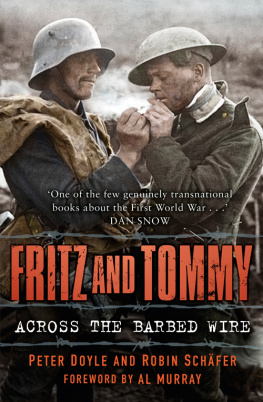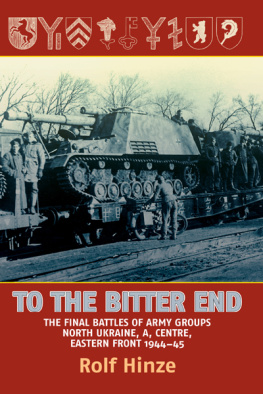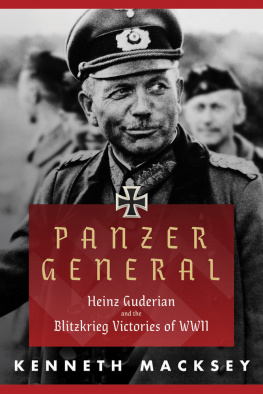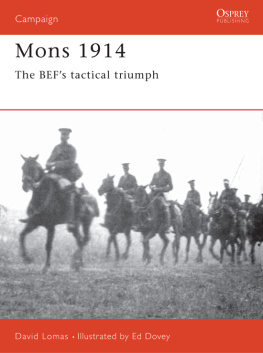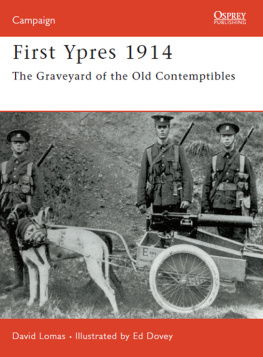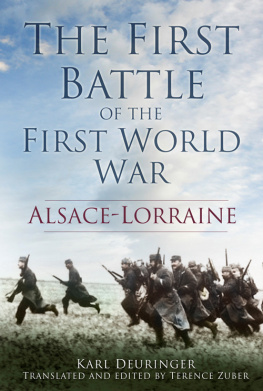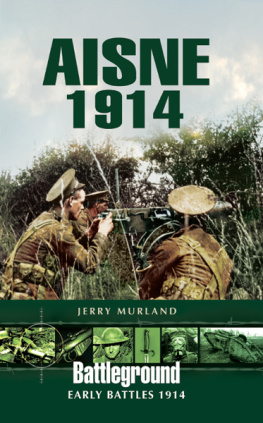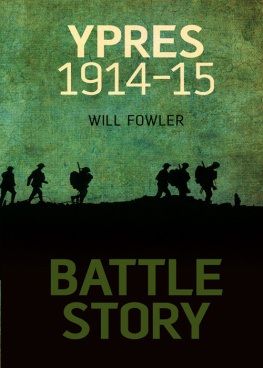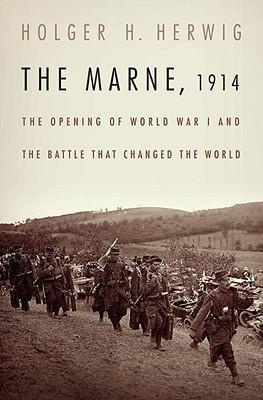HOME BEFORE THE LEAVES FALL
In Memory of Henri-Alban-Fournier, author of Le Grand Meaulnes and Lieutenant in the 288 Rgiment dInfanterie. Killed in action in the Fret de Calonne in the Eparges sector 22 September 1914, aged 27, and buried in the cemetery of St Rmy-la-Calonne.
And also of August Macke, member of the Blaue Reiter group of artists and Feldwebel Leutnant in Reserve-Infanterie-Regiment Nr 60.Killed in action at Perthes-les-Hurlus on 26 September 1914, aged 27, and buried in the military cemetery at Souain.
As bronze may be much beautified
By lying in the dark damp soil,
So men who fade in dust of warfare fade
Fairer, and sorrow blooms their soul.
Wilfred Owen
HOME BEFORE THE LEAVES FALL
A New History of the German Invasion of 1914
IAN SENIOR
CONTENTS
LIST OF MAPS
LIST OF PHOTOGRAPHS
INTRODUCTION
O n 18 January 1871, in a lavish and elaborately choreographed ceremony in the Hall of Mirrors at Versailles, Prussia celebrated its victory in the FrancoPrussian War and King Wilhelm I was proclaimed Emperor of a united Germany. After a peaceful interlude which lasted for more than 40 years, in the first week of August 1914 the two adversaries went to war once more in a conflict that this time engulfed the other great European powers. During the intervening period, the parameters that governed warfare were transformed as a consequence of accelerating technological and economic change. Firstly, armies increased more than fivefold in size because of rapid population growth (Germanys population, for example, increased by 17 per cent between 1890 and 1914), they required far greater quantities of equipment, food and ammunition and their deployment necessitated an elaborate and costly rail network (not all of whose lines were suitable for civilian traffic). This put an enormous strain on military budgets, especially in Britain and Germany which towards the end of the period became locked into an enormously expensive naval race. Secondly, new and improved weapons made the battlefield a much more lethal environment, especially during an assault against prepared positions. With the advent of more powerful rifles, the zone of death which separated the attacking infantry from the enemys lines increased from about 300 metres during the FrancoPrussian War to approximately 1,500 metres in 1914. At the same time, the situation was exacerbated by the appearance of the machine gun, with a range of up to 2,000 metres and a rate of fire greater than 500 rounds a minute. Likewise, the effectiveness of artillery underwent a steep change in the last years of the 19th century fuelled by developments in metallurgy and chemistry that resulted in more powerful guns, able to hurl their shells over far greater distance than during the FrancoPrussian War, and by the invention of the recoil mechanism during the 1890s which greatly increased the rate and accuracy of fire. (The famous 75mm French field gun, or soixante-quinze as it was generally known, could fire at up to 15 rounds a minute and with increased accuracy because it remained completely steady during firing and therefore did not need to be repositioned between each round.) As a result of these changes many well-informed commentators began to suspect that the task of capturing the enemy positions by assault would be too great for even the most highly trained and well-led infantry, despite high morale and excellent artillery support. When these facts received wide attention in the two decades before 1914, the idea took firm hold that wars in the future would have to be short (or might even be impossible altogether) because the human, social and economic costs would be too great to beat.
This point of view was most strongly expressed by the Polish banker and pacifist, Jan Bloch, whose enormous six-volume book, The Future of War in its Technical, Economic and Political Aspects, was translated into German in 1899. Although the German military establishment did its best to pick holes in Blochs arguments, his ideas were well-received and were repeated in a more digestible form in articles in learned journals and in books for a wider audience by authors such as the English Professor, Norman Angell. Although the events of 1914 were to prove Bloch and his adherents wrong, the illusion of the short war permeated all levels of society and all walks of life, from the politicians at the top, to the generals in charge of planning and preparing for the campaign, down to the ordinary man and woman in the street. The plans with which the Germans and the French went to war (the Schlieffen-Moltke Plan and Plan XVII respectively) were therefore based on rapid deployment, on seizing the strategic initiative and on attacking the enemy without delay. The importance of stealing a march on ones opponents and striking the first blow was the paramount factor which governed their strategic thinking.
It is hardly surprising therefore that almost everyone, soldiers and civilians alike, firmly believed that the fighting would be over within a few months and that the troops would be home in time for Christmas. (On the British side, the only important figure to voice his misgivings was the newly appointed Minister for War, Lord Kitchener, who startled his incredulous colleagues by suggesting that the war would last for at least three years and that it was vitally important to recruit a large number of volunteers who would need between one to two years training before they were battle-worthy.) In Berlin, Kaiser Wilhelm II (whose second son, Prince Einzel Friedrich, was in command of the elite 1st Regiment of Foot Guards) said farewell to units of the Prussian Guard as they were about to leave for the front, telling them that they would soon be victorious and would return before the leaves fell. Likewise, officers in the British Expeditionary Force told their loved ones that they would be home before Christmas while those who were left behind pulled all the strings they could in a desperate effort to join their comrades in France before the fighting came to an end. In both France and Germany the troops who enthusiastically chalked Berlin or nach Paris on the sides of their troops trains as they set out for the front never thought for one moment that it would last for over four years and that very few of them would be alive and uninjured when it finally came to an end.
To begin with, it must have seemed to many Germans that the Kaiser had been right and that their men folk would indeed return home in time to celebrate Christmas with them. After an initial delay when it took four days longer than expected to seize the strategically important city of Lige (the bottleneck through which the right wing had to pass at the start of the campaign), by the end of August the French armies had been defeated all along the frontier. As far as the German High Command was concerned, the war was as good as won. Less than two weeks later, however, the Germans were defeated in the battle of the Marne and the campaign which had held out so much promise only a short time earlier ended in defeat. Far from being over by December, the war dragged on for another four years, confounding the predictions of Bloch and his supporters but vindicating Lord Kitchener and a few other similarly prescient individuals in Britain and elsewhere. By the end of 1914, the French and German armies had each suffered around three quarters of a million casualties, a substantial proportion of which took place during the approximately three-week-long campaign. To put this into context, German casualties in the five-month-long Franco-Prussian War amounted to approximately 90,000 wounded and 28,000 dead. The aftermath of the five-day long battle of the Marne was described by an anonymous French soldier, who left a vivid description of his part of the battlefield immediately after the fighting was over and before there had been time to clear away the human debris.



